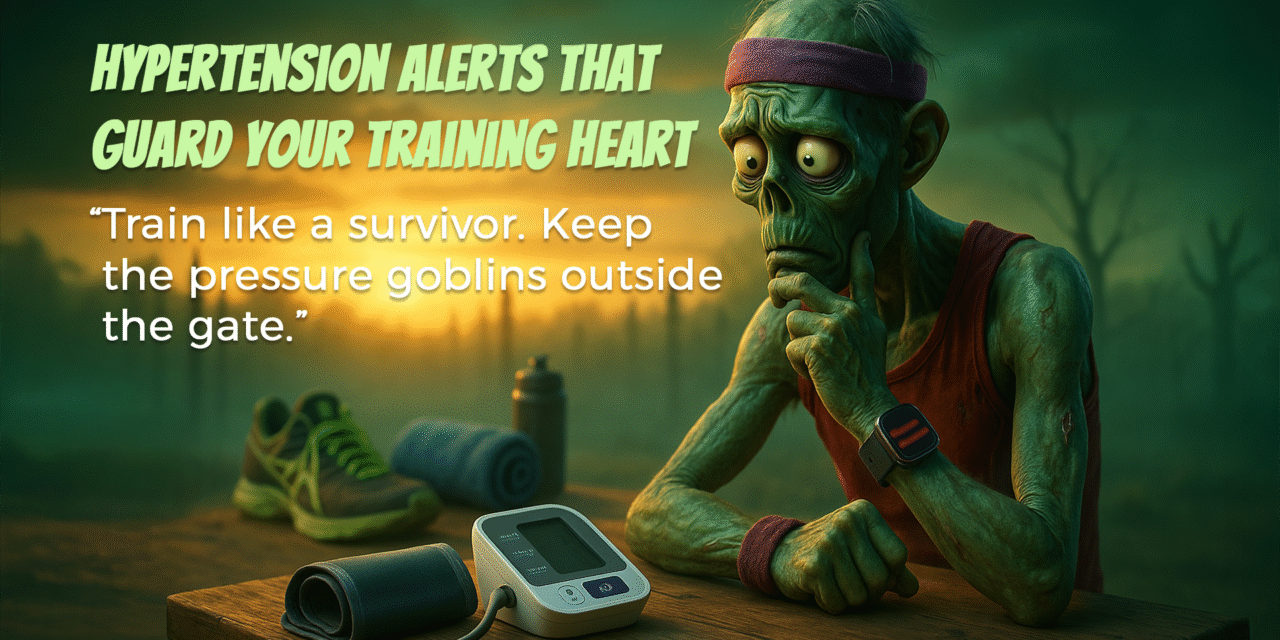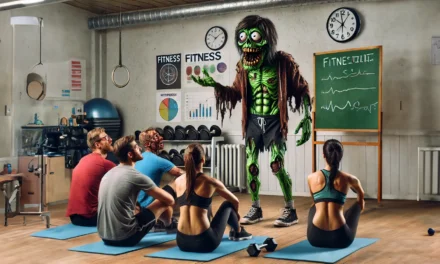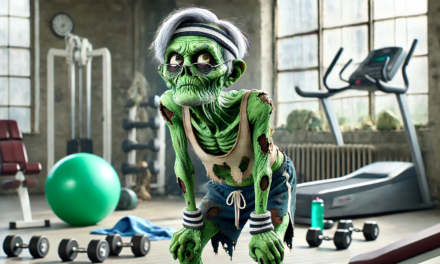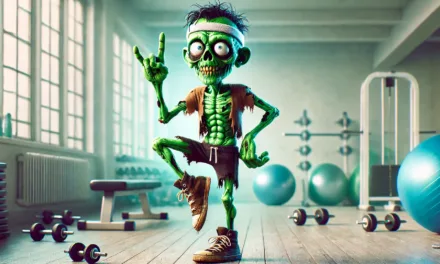The Wrist Siren: Apple Watch Hypertension Alerts, the Fitness Zombie-Style
TL;DR (Survival Log #11): The Apple Watch’s new Hypertension Notifications are like a perimeter alarm around your arteries. It scans 30 days of optical heart-sensor signals and whispers, “Possible high blood pressure.” It doesn’t give mmHg numbers and it isn’t a diagnosis. If it pings, don’t panic—run the 7‑day home cuff patrol, average the readings, then plan with your clinician. High specificity = few false alarms; moderate sensitivity = some cases slip past the gate. It’s a smart scout, not a doctor. Pair it with training, sleep, and an upper-arm cuff to keep the pressure goblins out of the keep.
The Siren That Watches While You Sleep
The feature arrived alongside Apple Watch Series 11 and is rolling out with watchOS 26. The watch quietly samples blood‑volume pulse waves (PPG) day and night, then reviews rolling 30‑day windows. If the pattern resembles persistent hypertension, you’ll see a banner that reads something like “Possible Hypertension.”
Translation to bunker-speak: this is a scout report from the wall, not a bite mark. It’s a nudge to check the gates with a real tool: an upper-arm blood pressure cuff. You’ll find the toggle in the iPhone Health app (Health Checklist → Hypertension Notifications). Most adults 22+ who aren’t pregnant and don’t already have a hypertension diagnosis can enable it, depending on regional approvals.
Hardware reality check: Apple enables this on Series 9 or later and Ultra 2 or later. The SE models sit this mission out. If you sprung for Series 11, you also get nicer daily-wear perks (better scratch resistance on aluminum models and solid battery for a full day in the wild).
What It Is (and Isn’t): Scout Report vs. Sphygmo‑Thingy
Is: A background screen with high specificity (few false alarms). If the siren wails, don’t ignore it.
Isn’t: A blood pressure monitor. No systolic/diastolic mmHg numbers, no medication decisions from the watch alone. Think: “heads‑up” → confirm with cuff → decide with clinician.
Why the caution? Hypertension diagnosis depends on averages across days, not one stressed‑out clinic reading and definitely not a casual wrist guess. The watch is good at spotting patterns that suggest trouble, but it will miss some cases (moderate sensitivity). “No alert” doesn’t guarantee “all clear.”
The Fitness Zombie translation: The scout is sharp‑eyed but sometimes drowsy. We fortify the gate anyway.
If the Wrist Siren Sounds: Run the 7‑Day Patrol Log
When the alert appears, treat it like an evacuation drill—calm, methodical, and logged. Here’s the clean protocol most clinicians love, adapted for your kitchen table:
- Get the right tool: an upper‑arm cuff that’s on a validated list (your clinician can recommend one). Wrist/finger toys are for Halloween costumes, not diagnoses.
- Timing: Morning and evening for 7 days.
- Pre‑flight: No exercise/caffeine/nicotine or heavy meal for 30 minutes beforehand.
- Position: Sit quietly for 5 minutes; feet flat, back supported, arm at heart level. No talking.
- Two readings each time, 1–2 minutes apart. Write down both.
- Average your readings for the full week (many protocols drop day 1 as a warm‑up).
- Share the log with your clinician. If possible, bring the cuff to your visit so they can check calibration.
What numbers matter? In most U.S. guidance, an average ≥130/80 mmHg counts as hypertension. Your plan will depend on your overall CV risk, age, and context. The key is the average, not one jump-scare reading after sprinting up the stairs with grocery bags and a Labrador.
Mindset: You’re not “sick.” You’re scouting. Confirm, then act.
Why Athletes Should Care (Yes, Even You With the VO₂ Flex)
Hypertension isn’t a villain you feel sneaking up. It’s a quiet leak in the hull that raises long‑term risk and messes with recovery. Elevated pressure can impair endothelial function, nudge resting heart rate north, and raise the cardiovascular cost of the same training load. Even fit humans can carry stealthy high BP, especially with family history, stress, caffeine habits, or sleep issues.
The watch’s edge: It watches your everyday signals—sleep, commutes, easy miles—over 30 days, not a single white‑coat moment. That long lens helps surface patterns you’d otherwise ignore until your annual checkup. Then you bring in the cuff, get the truth, and tune your training.
The Training Playbook: How to Push the Pressure Goblins Back
This is the boring magic that works. Consider these as loadable levers—adjust based on your training block and recovery:
- Aerobic Volume (Zone 2 Is a Moat)
- Aim for 150–300 minutes/week of moderate aerobic work or 75–150 minutes/week vigorous. Don’t chase heroics; chase consistency. Two or three longer Zone 2 sessions plus a couple of shorter tempo/interval touches often beats one “epic” sufferfest.
- Strength Training (2–3 Days/Week)
- Moderate loads, full‑body movements, smooth bar speed. Use proper breathing—avoid long Valsalva breath‑holds on max attempts if your BP is high or unconfirmed. You can get brutally strong without playing “squeeze the skull” on every rep.
- Sodium Sense (Smart, Not Spartan)
- Match sodium to sweat for long/hot sessions; otherwise, ratchet down default processed-food salt. If you’re on BP medications, confirm supplements/electrolyte plans with your clinician.
- Weight Management (Small Cuts, Big Wins)
- For many, losing 5–10% of body mass nudges BP down meaningfully. Slow cuts preserve performance and sanity; think quarter‑pound per week, not a zombie crash diet.
- Sleep: The Real Recovery Potion
- Protect schedule and duration. Nudge your sleep latency down: dim lights, regular wind‑down, screens out of the bunker.
- Alcohol & Stimulants: Know the Trade‑offs
- Alcohol lifts BP in a dose‑dependent way; caffeine timing matters. Pull the levers you can live with.
- Medication Coordination
- If you start antihypertensives, ask about dose timing relative to key workouts and races. Some meds can affect HR response or perceived exertion—plan accordingly.
Apple’s Approach vs. Samsung’s (Two Camps Outside the Walls)
- Apple: No on‑wrist mmHg numbers. Instead, a screening notification with regulatory clearance in many regions. Clear message: confirm with a cuff and manage with your clinician.
- Samsung: In many countries, Galaxy Watch can show on‑device BP estimates—but only after regular calibration with a real cuff, and U.S. authorization remains limited for BP measurement. Philosophy: give numbers (with caveats); still push you back to a cuff for accuracy.
The Fitness Zombie verdict: Different roads, same destination: you end up with a validated upper‑arm cuff to make decisions. Apple’s lane favors high‑specificity alerts; Samsung’s lane offers numbers with the calibration tax.
Common Traps (How Survivors Get Picked Off)
- Panic buying: One alert and you order three cuffs, two supplements, and a medieval salt‑ban. Breathe. Run the 7‑day protocol first.
- False confidence: “No alert, I’m immortal.” The scout isn’t perfect. If you have risk factors, run periodic home checks anyway.
- Cuffless fantasies: Any gadget promising clinic‑grade mmHg without calibration should raise your eyebrow like a drawbridge. Use real cuffs for the truth.
- Valsalva roulette: Grinding maximal lifts with breath held forever spikes BP in the moment. Use your bracing smartly and don’t live at RPE 11.
- Data hoarding, zero action: Cool graphs won’t lower BP. Training, sleep, salt strategy, and follow‑through will.
Gear Locker: What to Buy (and Avoid)
Watch compatibility: Hypertension notifications require Apple Watch Series 9 or later / Ultra 2 or later running the latest software. SE models aren’t supported. If you’re upgrading, Series 11 adds durability and battery perks that play nicely with sweaty, chaotic lives.
Cuff guidance: Choose an upper‑arm model from a validated list. Features that matter: right cuff size for your arm, easy memory/export, and a power plan that suits your routine (AA batteries vs. rechargeable). Skip wrist and finger gadgets for diagnostic use. If budget is tight, a no‑frills validated cuff beats a fancy inaccurate one.
Set-up tips:
- Read the manual (I know), pick the correct cuff size, and practice on a calm evening before your first patrol morning.
- Keep a small notebook or use your phone’s health app to log readings with timestamps.
- If you lift heavy in the mornings, take the reading before training.
The 10‑Minute Action Plan (Tear‑Out Page)
- Flip the switch: iPhone Health → Health Checklist → Hypertension Notifications.
- Procure the cuff: upper‑arm, validated, correct size.
- If alerted: run the 7‑day morning/evening protocol; average the numbers.
- Book the chat: send the log to your clinician; bring the cuff if possible.
- Train the basics: Zone 2 moat, 2–3 strength sessions, sleep guardrails, sodium sense.
- Check again in 3–6 months: (or sooner if told) even if the first log is clean.
FAQ From the Bunker
Q1: Will lifting spike my blood pressure?
Yes—acutely. Heavy sets and breath‑holding raise BP briefly, like a controlled explosion. That’s normal but not a reason to live at max strain if your baseline is high or unconfirmed. Use steady breathing and reasonable RPE most days.
Q2: Do smartwatches replace cuffs?
No. They’re great sentries. The decision tool is still the upper‑arm cuff.
Q3: I got one high reading—am I doomed?
Single readings are noisy. That’s why we average over days. Run the patrol log.
Q4: How accurate is Apple’s alert?
Think high specificity (few false alarms) and moderate sensitivity (it will miss some). If it pings, treat it seriously; if it doesn’t, you still might benefit from periodic home checks.
Q5: Who shouldn’t rely on the alert?
If you’re pregnant, under 22, or already diagnosed/treated for hypertension, this feature isn’t targeted at you. Follow your care plan and your clinician’s guidance.
Q6: What about privacy?
Your health data lives in your device ecosystem. Use passcodes, two‑factor, and share data selectively. If you’re syncing to third‑party apps, check their policies like you check the locks at night.
Coach’s Notes for Race Season
- Taper weeks: High stress and low sleep can nudge BP up. Keep caffeine predictable and get your aerobic “easy miles” done early in the day.
- Heat camps: Hot blocks demand sodium. Balance your day‑to‑day salt with training load instead of treating salt like a moral category.
- Weight‑class sports: Be careful with rapid water cuts and diuretics. Short‑term yo‑yoing plays badly with BP and recovery. Aim for slower, smarter recomposition phases.
- Travel: Time zone shifts, airplane dehydration, and erratic meals push BP around. Hydrate steadily, walk the aisle, and front‑load sleep the first two nights.
The Bigger Picture: Why This Matters
With millions of wrists wearing an FDA‑cleared, high‑specificity screen, a lot of undiagnosed hypertension can get flagged earlier—especially among people who rarely book clinic visits because they “feel fine.” This is the power of passive monitoring done responsibly: fewer false alarms, a clear path to confirmation, and an easy handoff to actual care.
The Fitness Zombie take: Celebrate the siren, but don’t worship it. The win is what you do after it rings: run the patrol, average the week, plan your defense. Then train like a survivor—not a statistic.
“Hold the Wall, Then Lift”
If the watch sounds the alarm, that’s not doom music—it’s a heads‑up from a friend on the ramparts. You already know what to do: grab the cuff, log the week, and fix the basics. We keep moving, we keep lifting, and we keep the pressure goblins outside the gate.
(Note: This article is coaching guidance, not medical diagnosis. Confirm your own plan with your mortician uhm doctor.)
I'm on a lifelong quest to find the perfect balance between strawberry smoothies and pizza slices. A self-proclaimed gym enthusiast who believes rest days are just as crucial as leg days—especially if they involve NASCAR racing. I lift weights, but only so I can justify my love for chocolate cake. When I'm not at the gym, you’ll find me riding dirt bikes or capturing the thrill of motorsport through my camera lens. Join me as I navigate the highs and lows of fitness, where progress is measured in reps, and cheat meals are a form of self-care.
If you shuffle through my links and make a purchase, I might earn a commission—these are affiliate links and come at no extra cost to your living soul, just zombie perks to keep this corner of the internet undead and kicking!





